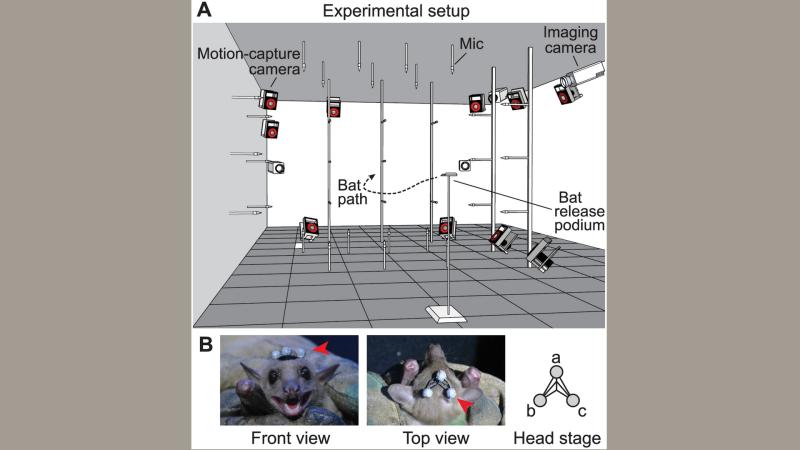
Egyptian fruit bats are nocturnal, fruit eating bats that are found in Africa and parts of Asia. Like many of their other closely related cousins (species), they use high-frequency sound waves to navigate and find their food. But there is one aspect of the Egyptian fruit bats (Rousettus aegyptiacus) that has baffled scientists until now. While most bats move their heads, nose, ears or mouth to change the direction of the sound waves they produce, these bats do so without any visible movements in their head or body. Now, a study by researchers from the University of Washington, USA, Johns Hopkins University, USA and the Indian Institute of Science Education and Research (IISER) Pune, has revealed how these bats may use their tongues to change the direction of sound waves.
Among the 1300 species of bats found in the world today, about half of them ‘see’ using sound waves through a behavior called echolocation. Echolocating bats send a high-frequency sound wave in a sonar beam towards objects and listen to the returning echoes. The returned echoes give them a glimpse of their surroundings, much like a flashlight illuminating a section in the dark. They also change the direction of these sound waves to scan different parts of their surroundings. Some bats, including the Egyptian fruit bat, produce sharp clicks with their tongue to generate the sound waves, while other bats produce longer calls from their larynx.
Previous studies have shown that Egyptian fruit bats emit clicks in pairs, alternating towards the left and right directions and within as quick as 20 millisecond. The click directions can point to as large as 60 degrees apart. In the present study, published in the journal PLOS Biology, the researchers found evidence suggesting that the beam direction is changed by changing only the position of the tongue. The researchers hypothesised that the bats move their tongues to generate rapid alternation of click directions. Although similar mechanisms had been suggested for other species of bats, none were experimentally tested for any bat species prior to this research.
The researchers of this study conducted various experiments on three Egyptian fruit bats to unravel the mystery. “The bats were acquired from the wild in Israel”, shares Dr. Anand Krishnan, one of the researchers of the study from IISER Pune. “They're quite easy to rear. The bats are wary of people at first, but become very tame and gentle with training and handling. After that, they can even be trained to perform several behavioural tasks”, he adds, explaining how the researchers conducted their study.
During the experiments, the researchers released the bats from a podium. While the bats were flying, they used 10 high-speed motion capture cameras to measure the bats’ head movement. They also measured the echolocating clicks using ultrasonic microphones. They then reconstructed the bat’s sonar beam using the microphone recordings and its head and overall movements using reflective markers placed on the bat’s head. Through modelling and three-dimensional computations, the sonar beam patterns were also studied.
The researchers found that their hypothesis was supported by the experimental observation. This study presents the first evidence that the direction of sonar beam can be changed by moving the tongue, which causes changes in phase difference across a series of sound sources located along the side of the bat’s mouth. Dr. Krishnan calls it, “a remarkable coincidence of engineering design and biological principles”, as the bat’s mechanism is broadly similar to human engineered phase arrays that allow steering of a beam of radio waves in different directions without moving the antennae.
‘Bio-inspired’ designs help us to create and improve technologies by choosing and applying the best principles from nature. The researchers say that this study might serve as an example where our inventions could have helped understand nature better. “Although many biological discoveries have led to engineering innovation, this study is an important step in using human engineering design principles to elucidate fundamental biological concepts”, Dr. Krishnan opines. “The inspiration goes both ways. We will be able to learn important engineering principles from nature such as figuring out the adaptive strategy for sensing the ever-changing environment, and also potentially combine a variety of sensory mechanisms, the way animals naturally do”, adds Dr. Wu-Jung Lee from University of Washington, who is also a the corresponding author of the study.






